The Huntsman Explorer SD7 is the dawning of a new era for this highly respected Kiwi boat builder with it being their first ever foray into the sterndrive market.
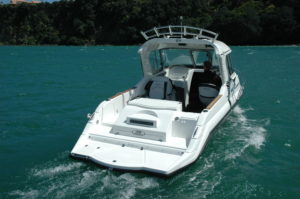
I have had the privilege over the years of being able to review almost every model that CSB (Canterbury Superior Boats) and later CSB Huntsman has ever produced and each one has always proven somewhat of a surprise package. However, for whatever reason, I have never had the privilege of writing a full review on the flagship of the fleet, the 7m Explorer. Well not until now, that is.
From the earliest Stingray ski boats and the hugely successful Dorado to the top of the line Crusader and enduring Series 6000, I have always looked forward to checking out what designer Geoff Robinson has come up with. His latest creation, called the Explorer SD 7 (7m sterndrive diesel) while fashioned from the existing Crusader has had a whole new transom crafted on the back to handle the new engine package.
Based primarily on the Crusader hull, the Explorer goes that extra step with the comfort and luxury of total weather protection in an attractive, yet very functional hardtop.
Redesign
Until now every CSB Huntsman boat built has had outboard power, so the SD7 is not only the first with a diesel sterndrive, it is also the first ever sterndrive installed in a Hunstsman. So why the change?
Geoff Robinson, MD of CSB Huntsman Boats, says one of the main criteria for the diesel option came about because of the fuel price. “We wanted to build a boat that was more economical to run than what we had and also had a good long range”.
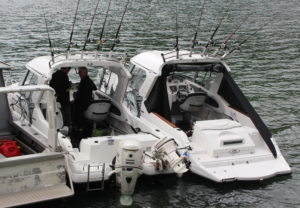
Geoff adds, “The idea of the diesel was quickly followed by the addition of a sterndrive and as we had already decided to use the Explorer hull as the basis for the new project, it came together very easily”.
The builders had to make some substantial changes to the back end of the boat which required a complete redesign to incorporate the extended platform and engine cover. The height of the platform was also critical as Geoff wanted it to be suitable to fish from and not get your feet wet, as well as being easy for divers and swimmers to get back aboard.
Built in as part of the new platform is a telescopic ladder with moulded cover and a hatch that provides access to the sterndrive. It is ideal if you need to get something unwrapped from around the propellers and also for servicing the leg.
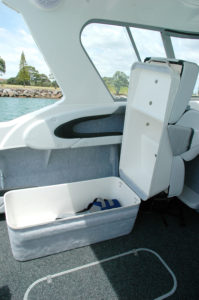
The engine cover features a rear facing moulded seat in the centre facing aft, which is a great place to sit down between bite times. There is another seat, complete with removable cushion at the forward end of the engine box, which complements the two rear transom bin seats. These are surprisingly large and make great fish or bait bins. There’s a walk-through on the port side, complete with drop-in splash board, with a wet locker/live bait tank on the opposite side of the engine box. The engine box also includes a large cutting board and you can also have an optional Manta bait station with six rod holders. Add that to the overhead Manta rocket launcher and the two coaming rod holders and there’s stowage for 14 rods!
“Right from the start we set about making the SD7 a serious fishing boat, more than a weekender, hence the cutting boards, rod holders, live bait tank and seriously large boarding platform”, says Geoff. However, there is the option of adding a toilet, hot and cold fresh water, a hand held shower and a BBQ style cooker if you want to set the boat up more for cruising than fishing.
Sharing the same proven hull as the Crusader, the Explorer with a 21-degree variable deadrise and strakes that run parallel along the length of the boat before cutting up into the chine, help to keep the boat dry and give the hull more forward lift.
Compact & Quiet
Hidden neatly and as compactly under the split engine box is a Hyundai SeasAll S250 coupled to a Bravo 3 leg. The Hyundai SeasAll S250 is a 3.0L V6 piezoelectric-controlled common rail diesel and produces 250hp @3800rpm and 490Nm of torque @ 2500rpm. Hyundai SeasAll has produced a superb small diesel that is ideally suited to larger trailer boats. Not only is the engine itself light in weight (334kg), the common-rail design also makes it quiet and fuel efficient, with extremely compact dimensions.

The S250 uses a compacted graphite iron (CGI) for the cylinder block, which according to Hyundai makes the engine lighter and quieter than conventional grey cast iron. After spending a morning running the SD7 on Auckland Harbour I can certainly attest to the quietness of the engine, especially at idle, when diesel engines having a mechanical fuel pump are especially noisy.
The S250 is EPA Tier 2, IMO Tier II, and RCD certified for those looking for a ‘green’ diesel engine option.
Performance

So with all that in mind I was keen to see just how the S250 and SD7 matched up.
Unquestionably, it’s a great combo and the overall performance is exceptional. Auckland Harbour tossed up some wild conditions for the test, with winds of 30 knots gusting to 45 knots, a short, steep sea, driving rain and the sort of day on which normally you would never venture out on the water unless you really had to. Well, we did, as circumstances dictated that we only had a one-day window to do the test, so what we got was what we got! Launching at Gulf Harbour, the benefit of the protection of the new breakwater around the ramp was again appreciated, with some shelter from the gale force westerly.
I had borrowed new Great Wall V200 diesel to tow the boat from Rogers Boat Shop, Albany to Gulf Harbour and I have to say I was pleasantly surprised at the tow ability of this double cab ute. Whilst having a rated tow capacity of 2000 kgs, I had no issues towing the 2400kg Huntsman SD7 and watercrat trailer in driving rain on the motorway and even pulled the boat out on the ramp afterwards still in 2WD.
I was able to really give the SD7 a good hard run, firstly in a following sea all the way to the end of the Whangaparoa Peninsula and then turned it around and ran it straight back into a stiff and rising westerly.
Immediately on leaving the ramp and pushing down the throttle you appreciate the power of the engine, especially when the turbo cuts in and it gets right up to top rpm very quickly. However, conditions were such that there would be no flat-out driving. Running with the sea, we sat around 3000 rpm at 33 mph. I had a little tab on and almost no trim. The sterndrive doesn’t seem to need it. The ride was great and I felt we could have easily gone a lot quicker.
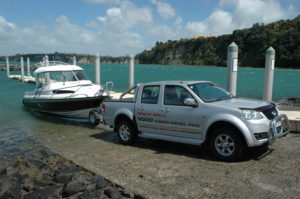
Turning around and running straight into the steep sea wasn’t pleasant, but I doubt any 7m boat would have liked the 1m plus sea coming head on/ With the trim hard in and again just a little tab we ran back at around 17 knots @ 2000 rpm. This seemed most comfortable and would relate to the speed you would do if you had your family aboard.
The massive blade area of the twin props on the Bravo Three leg result in a fast idle speed in forward and reverse that requires you to maintain focus and carefully manoeuvre the boat around tight situations, but result in other performance benefits. However CSB Huntsman are considering offering the Bravo One leg as an option. This according to Geoff will perform at idle similar to an outboard and would enable trolling without the addition of an auxillary engine.
Although there was no calm water anywhere nearby, we had fortunately been able to get all our speed and fuel figures done sometime earlier on a calm Lyttelton Harbour.
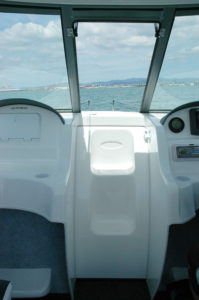
Flat out in calm water the GPS indicated 39.9 knots @ 3900 rpm. The fuel consumption, according to the Hyundai fuel management indicator, was 49.5L/h or 1.24L/NM. Interestingly, the same boat with an Evinrude ETEC 175 does exactly the same speed but uses 63L/h for 1.58L/NM @ 6000 rpm. At 3500rpm the Explorer outboard cruised along at 22.6 knots, burning 21L/h or 0.93L/NM, giving a range 145NM, of based on a 150 litre fuel tank and a 10% reserve. At around the same speed the SD7 ran at 2500 rpm and used 18L/h or 0.80L/NM, giving a range of 169NM. Drop in the long range 200-litre tank and the range at a 22.6-knot cruising speed increases to 194NM for the outboard and 225NM for the diesel sterndrive.
The fuel costs are also significantly in favour of the diesel. Based on prices of $NZ1.55/L for diesel and $NZ2.26 for petrol on October 15th 2012, the fuel cost per NM at 22.6 knots would be $NZ2.10 for the outboard compared with $NZ1.24 for the diesel – a saving of $NZ0.86 per NM.
Proof positive is right there that the diesel sterndrive package is a cheaper-to-run option and that’s exactly what the idea behind the SD7 was all about. Conversely however, the cost of the engines are significantly different, with the RRP for the Hyundai SeasAll S250 at around $NZ54,000 (incl. props, gauges and remotes) and a similarly set up 175hp outboard around $NZ28,000, a difference of $NZ26,000. Is it worth almost double the price of the engine package to go diesel? You decide!
Weekend Capable
The Explorer was released in late 2008 as CSB Huntsman’s first hardtop and was based on the already proven 6.5m Crusader hull. The footprint for the hardtop was crafted onto the existing Crusader deck. One small change to the SD7 over the previous Explorer is a raised fibreglass shroud around the base of the hardtop windows. This has been done for no other reason than aesthetics, to make the wheelhouse seem lower than it really is.
Within the new hardtop, the full bodied Explorer offers very generous space for a boat of its length. The added internal volume has been made available by the lack of need for side decks, thanks to the unique walk-through centre windscreen within the hardtop, which provides the access to the foredeck. While out on the water the access forward to the deck is easy. We simply closed the sliding cabin door, (which has the access steps built into it) flipped up the centre screen and easily climbed through. With no side decks, Huntsman has been able to push the useable interior space almost to the full beam of the boat.
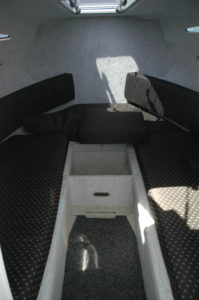
With the lockable cabin door open there is wide access to the forward fully lined cabin; again the cabin has been pushed out to utilise almost the full width. A large V-berth quickly changes into a large double berth by the insertion of a squab infill. There is good storage space available on the side shelves that run the length of the cabin area. There is a centre infill squab that covers an area suitable for a portable toilet.
The small cabin windows, combined with the overhead access hatch and good cabin headroom there was little risk of claustrophobia setting in. The hatch also provides good ventilation and further access to the foredeck.
Hardtop Protection
Both when standing and when seated at the helm, the hardtop offered great protection from the sun and wind, and in the winter from the cold conditions.
With the addition of a full canvas backdrop you can close in the entire cockpit, making it a great boat for weekending. The skipper’s seating is in the form of a swivelling pedestal seat, which is four-way adjustable – great for skippers of differing sizes and shapes. Standing headroom is generous and visibility is excellent through the New Zealand made Seethru glass windscreen. The sliding side windows offer good ventilation; lift the centre windscreen when stationary and you have excellent airflow throughout the cabin area.
Instrumentation is uncluttered and easily viewed, the dash providing lodgings for the Lowrance HDS 5 fishfinder and GPS. There is a comfortable footrest, which is repeated on the passenger’s side – if your legs are long enough to reach it. The passenger side has a good-sized glove box and drink holder.
Same Layout
While everything from the original transom aft is new, everything forward is the same as in the Crusader and Explorer, albeit a restyled cabin window. There is a king/queen seat to the port with huge storage under. The SD7 also has decktread and rubber rib matting in the aft section of the cockpit sole, which for fishing is designed to be more suitable than carpet.
Deep toe kicks run along the edge of the cockpit, allowing fishers to get right up close against the coamings when the action hots up. Also for fishers is the option to remove the marine carpet that covers the cockpit sole. Along each of the cockpit sides, there are deep pockets for storage and racks for rods, and there is a smaller additional shelf for storage located above. The high deck coamings offer a sense of security – particularly for those with younger family members.
There is more storage just forward of the underfloor fuel tank (150-, 175- or 200-litre options) by way of a large wet locker, which drains into a deep sump along with any other excess water from the cockpit, where a bilge pump is ready and waiting.
The batteries and oil reservoirs are safely stored with room to spare in the transom area.
Conclusion
Since its release in May, the Explorer SD7 that we tested in October was still the only one on the water. The boat was sold, but not delivered to its anxious owner until it had done a few boat shows and magazine tests in Auckland. The response according to Geoff has been very positive and by early November the second SD7 was due out of the factory.
Like every CSB Huntsman that I have tested (now all of them) it is a hard boat to fault. The finish, style and performance is exceptional and you just can’t find fault in any areas. It’s certainly a great package that works well. Breaking into the sterndrive market after all these years of offering outboard power only, has opened up a whole new market for CSB Huntsman. You can be assured that the SD7 is only the start, with talk already of a bigger version to cater for the weekender market.




